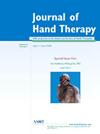Kinesio 胶带对腕管综合征的立竿见影效果:随机对照双盲超声波研究。
IF 2.1
4区 医学
Q2 ORTHOPEDICS
引用次数: 0
摘要
背景:目的:本研究旨在探讨 Kinesio taping(KT)对皮肤、皮下组织和正中神经的测量是否有影响,并比较两种不同 KT 应用的效果:这是一项前瞻性、双盲、随机试验。本研究已在 clinicaltrials.gov (NCT05475197)上进行了前瞻性注册。临床和电生理学诊断为轻度/中度腕管综合征的 34 名腕部患者(21 人)被随机分为两个 KT 干预组(第 1 组:神经技术和区域矫正技术;第 2 组:区域矫正技术):在基线和拔除 KT 后(48 小时),用视觉模拟量表评估疼痛,用手持式测力计评估手部握力,用捏力计评估捏力。同样,使用超声波测量了腕管入口和出口处的皮肤和皮下组织厚度、正中神经横截面积和扁平率以及正中神经深度:两组患者在 KT 术后疼痛评分(与基线相比)均有明显改善(第 1 组:p = 0.03,ηp2 = 0.44;第 2 组:p p2 = 0.71),但两者之间没有差异(p = 0.07,ηp2 = 0.10)。只有第 2 组的握力明显增加(p = 0.01,ηp2 = 0.35)。在基线和 KT 后,组内或组间的声像图测量结果均无明显差异(均 p > 0.05):结论:虽然 KT 后疼痛评分有所改善,但并不与超声波评估的任何形态变化相关联。本文章由计算机程序翻译,如有差异,请以英文原文为准。
Immediate effects of Kinesio taping in carpal tunnel syndrome: A randomized controlled double-blind ultrasonographic study
Background
The effects of Kinesio taping (KT) in carpal tunnel syndrome are controversial.
Purpose
This study aimed to examine whether KT has any effect on the skin, subcutaneous tissue, and median nerve measurements and to compare the effects of two different KT applications.
Study Design
This is a prospective, double-blinded, randomized trial. This study was prospectively registered on the clinicaltrials.gov (NCT05475197). A total of 34 wrists (21 patients) who were clinically and electrophysiologically diagnosed with mild/moderate carpal tunnel syndrome were randomly divided into two KT intervention groups (group 1: neural technique and area correction technique and group 2: area correction technique).
Methods
At baseline and immediately after the removal of KT (48 hours), pain was assessed with visual analog scale, hand grip strength with a hand-held dynamometer, and pinch strength using a pinch meter. Likewise, using ultrasound, skin and subcutaneous tissue thicknesses, median nerve cross-sectional area and flattening ratio, as well as median nerve depth were measured at the carpal tunnel inlet and outlet levels.
Results
While there was significant improvement in the pain scores (compared to the baseline) immediately after the KT in both groups (group 1: p = 0.03, ηp2 = 0.44; group 2: p < 0.001, ηp2 = 0.71), there was no difference in between (p = 0.07, ηp2 = 0.10). Grip strength significantly increased only in group 2 (p = 0.01, ηp2 = 0.35). None of the sonographic measurements displayed significant difference either within or between groups at baseline and after KT (all p > 0.05).
Conclusions
While pain scores improved after KT, they were not coupled with any morphologic changes assessed by ultrasound.
求助全文
通过发布文献求助,成功后即可免费获取论文全文。
去求助
来源期刊

Journal of Hand Therapy
医学-外科
CiteScore
3.50
自引率
10.00%
发文量
65
审稿时长
19.2 weeks
期刊介绍:
The Journal of Hand Therapy is designed for hand therapists, occupational and physical therapists, and other hand specialists involved in the rehabilitation of disabling hand problems. The Journal functions as a source of education and information by publishing scientific and clinical articles. Regular features include original reports, clinical reviews, case studies, editorials, and book reviews.
 求助内容:
求助内容: 应助结果提醒方式:
应助结果提醒方式:


